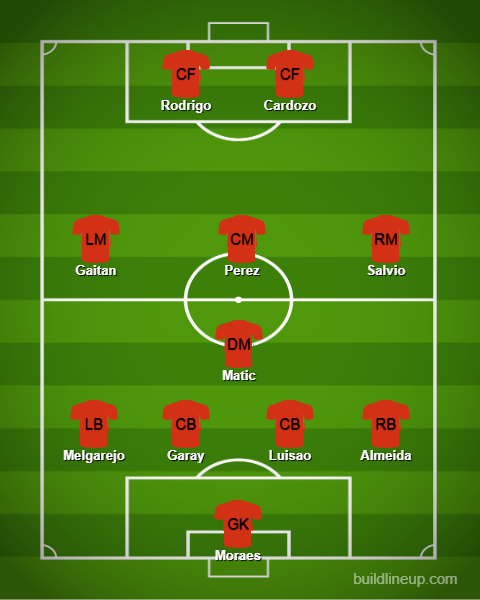In the world of soccer, formations play a crucial role in shaping a team’s strategy and gameplay. One such formation that has gained attention is the 4-1-3-2 formation. While not as commonly used as others, this system offers unique advantages and challenges for both teams and opponents. In this article, we will delve into the intricacies of the 4-1-3-2 formation, analyzing its uses, benefits, weaknesses, and examining notable examples of its successful implementation.
How to Play the 4-1-3-2 Formation
The 4-1-3-2 formation is an attacking system that focuses on dominating the final third of the pitch. It is a variation of the classic 4-4-2 shape, with a slight adjustment in the composition of the midfield. The formation consists of a back four with two center-backs, a right-back, and a left-back. A single central defensive midfielder, known as the pivot, provides crucial protection to the defensive line. The remaining five players in front of the pivot concentrate on creating chances and advancing the ball into the opponent’s half.
The three attacking midfielders in this system typically have a narrow positioning, focusing on linking up with each other and supplying the strikers. The central attacking midfielder takes on the primary playmaking role, while the left and right attacking midfielders engage in box-to-box play and provide support.
An example 4-1-3-2 lineup from Benfica’s successful 2012/13 team, led by Jorge Jesus.
The two strikers in the formation have the task of aggressively pressing the opposition defenders, aiming to regain possession high up the pitch. With the support of three attacking midfielders, the 4-1-3-2 formation can overwhelm opponents and incessantly launch attacks.
The Strengths of the 4-1-3-2 Formation
Compared to other formations, the 4-1-3-2 is designed with a clear attacking intent. It combines the attacking power of the 4-4-2 formation while narrowing the midfield to reduce the risk of being overrun in the center. The attacking central midfielders can drop back into a compact shape during defensive phases, allowing the two forwards to stay high and maintain an attacking threat.
In possession, the full-backs fill the wide spaces left by the narrow midfield, adding attacking width and creating opportunities to exploit the opposition’s defense. The presence of a single central defensive midfielder provides defensive stability, allowing the five players ahead of them the freedom to push forward and create dangerous chances.
The Weaknesses of the 4-1-3-2 Formation
While the 4-1-3-2 formation offers significant advantages, it also has its weaknesses. The narrow nature of the formation can restrict moves via the wings, particularly if the central midfielders drop into a diamond shape or lack skilled attacking full-backs capable of providing width. This vulnerability in wide positions can make teams susceptible to fast counter-attacks.
Additionally, when facing a midfield five, the risk of opponents dominating possession remains. Despite the reduction in surrendering possession to the opposition midfield compared to a 4-4-2, the 4-1-3-2 formation still faces challenges when up against a numerical advantage in the middle of the pitch.
Notable Examples of the 4-1-3-2 Formation
While not as widely used, several notable teams and managers have successfully employed the 4-1-3-2 formation.
Croatia, Slaven Bilic: During his time as the coach of the Croatian national team, Slaven Bilic utilized the 4-1-3-2 formation to great effect. This system played a significant role in Croatia’s victory over England in their Euro 2008 qualifying match at Wembley. Bilic maximized the talents of players like Luka Modric, Ivan Rakitic, Nico Kranjcar, and Ivica Olic, allowing them to thrive in a fluid playmaking system.
Manchester City, Roberto Mancini: Roberto Mancini, former manager of Manchester City, employed the benefits of the 4-1-3-2 system during the 2011-2012 season when City clinched their first-ever Premier League title. The formation accommodated an array of attacking talents, including Yaya Toure, David Silva, Samir Nasri, Edin Dzeko, and Sergio Aguero.
Sporting Benfica, Jorge Jesus: Portuguese coach Jorge Jesus successfully implemented the 4-1-3-2 system during his tenure at Benfica between 2009 and 2015. This formation played a crucial role in Benfica’s triumphs in various domestic competitions.
How to Play Against a 4-1-3-2 System
When facing a team using the 4-1-3-2 formation, specific strategies can be employed to exploit its weaknesses. One effective approach is to overload the flanks and take advantage of the gaps left by the narrow formation. Attacking the right-back and left-back positions can create one-on-one situations and expose potential weaknesses in those areas.
Another strategy is to focus on the center defensive midfield position. By pushing two midfielders or forwards into the area where the deep-lying central midfielder operates, you can outnumber and isolate them. This forces the playmaker to drop back and help their teammate, limiting their offensive impact.
By employing these tactics, you can disrupt the 4-1-3-2 formation and neutralize its strengths, increasing your chances of success. Remember, there are always ways to negate your opponent’s threat, regardless of the formation they employ.
Frequently Asked Questions:
Q: What is the most attacking formation in football?
A: One of the most attack-minded formations in football is the 4-1-3-2. This system revolves around three attacking midfielders and two advanced forwards. Other formations, such as the 3-5-2, which utilizes three defenders, can also emphasize attacking play.
Q: What is the 3-5-2 formation?
A: The 3-5-2 formation is widely popular in modern football. It features three central defenders, two wing-backs, a strong midfield trio, and two strikers. This formation provides balance across the pitch, and our article on the 3-5-2 formation offers further insights.
Q: What is the 4-4-2 formation?
A: The 4-4-2 formation is a classic shape that has been employed in football for several decades. It consists of a back four, two central midfielders, two wide midfielders, and two strikers. Our article on the strengths and weaknesses of the 4-4-2 formation provides a deeper understanding of this system.
In conclusion, the 4-1-3-2 formation offers a unique approach to attacking play in soccer. Although not as widely used as other formations, it has proven to be successful in the hands of skilled managers and teams. By understanding its strengths, weaknesses, and how to counter it, you can enhance your tactical knowledge and adapt your gameplay accordingly. For further insights into soccer tactics and positional play, visit Zerobertooficial.

